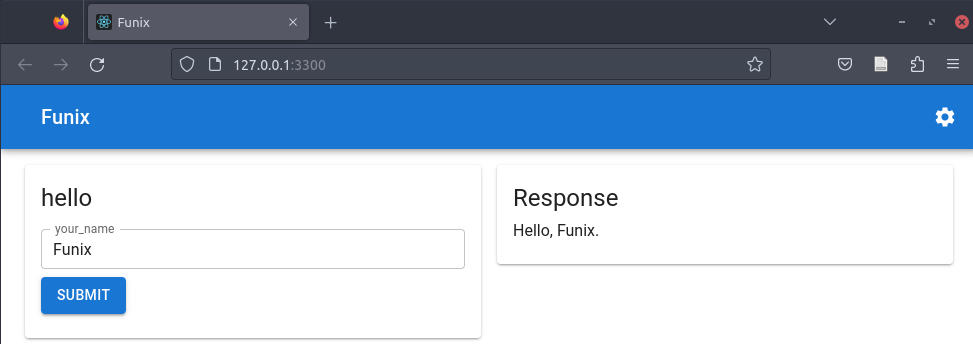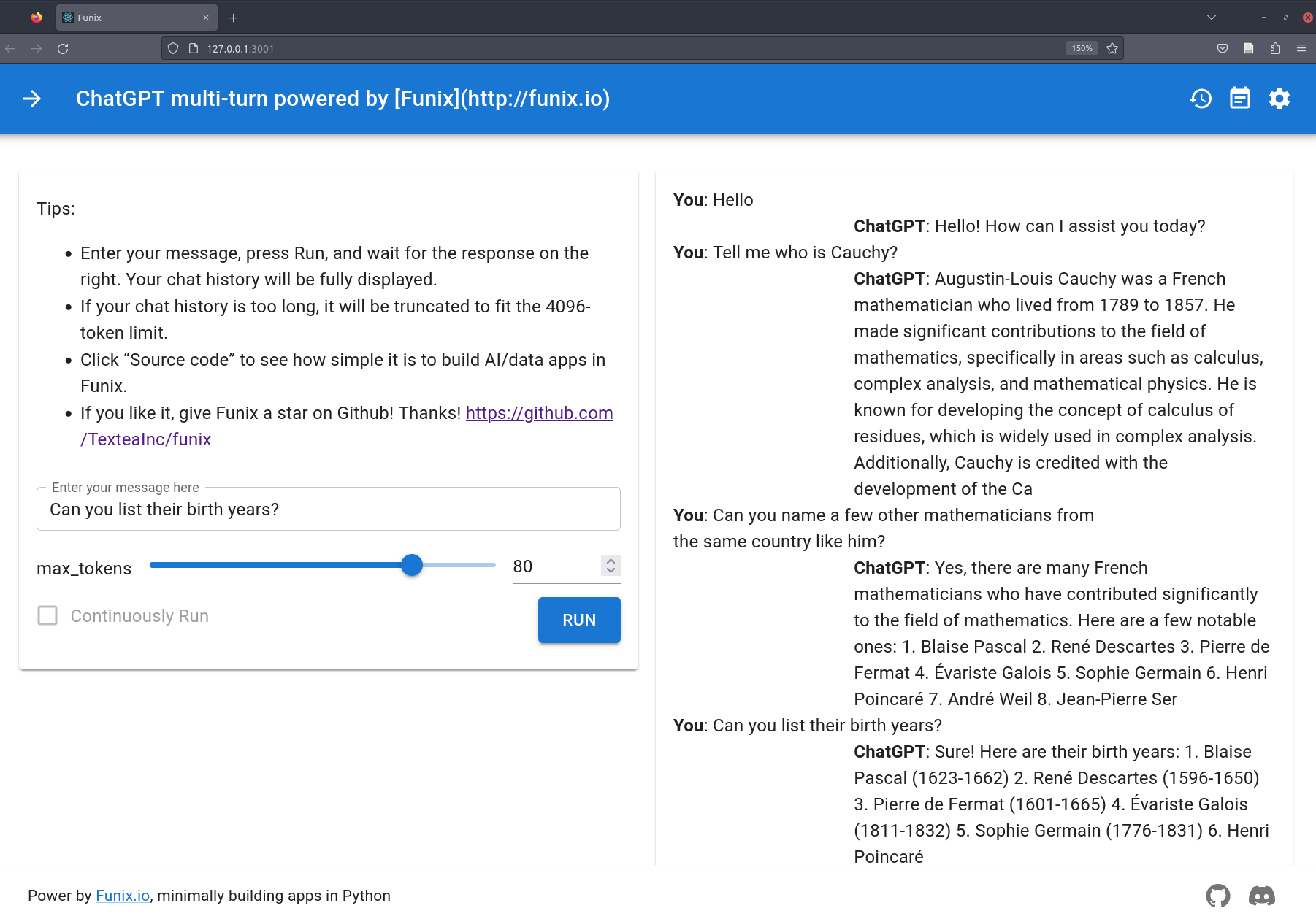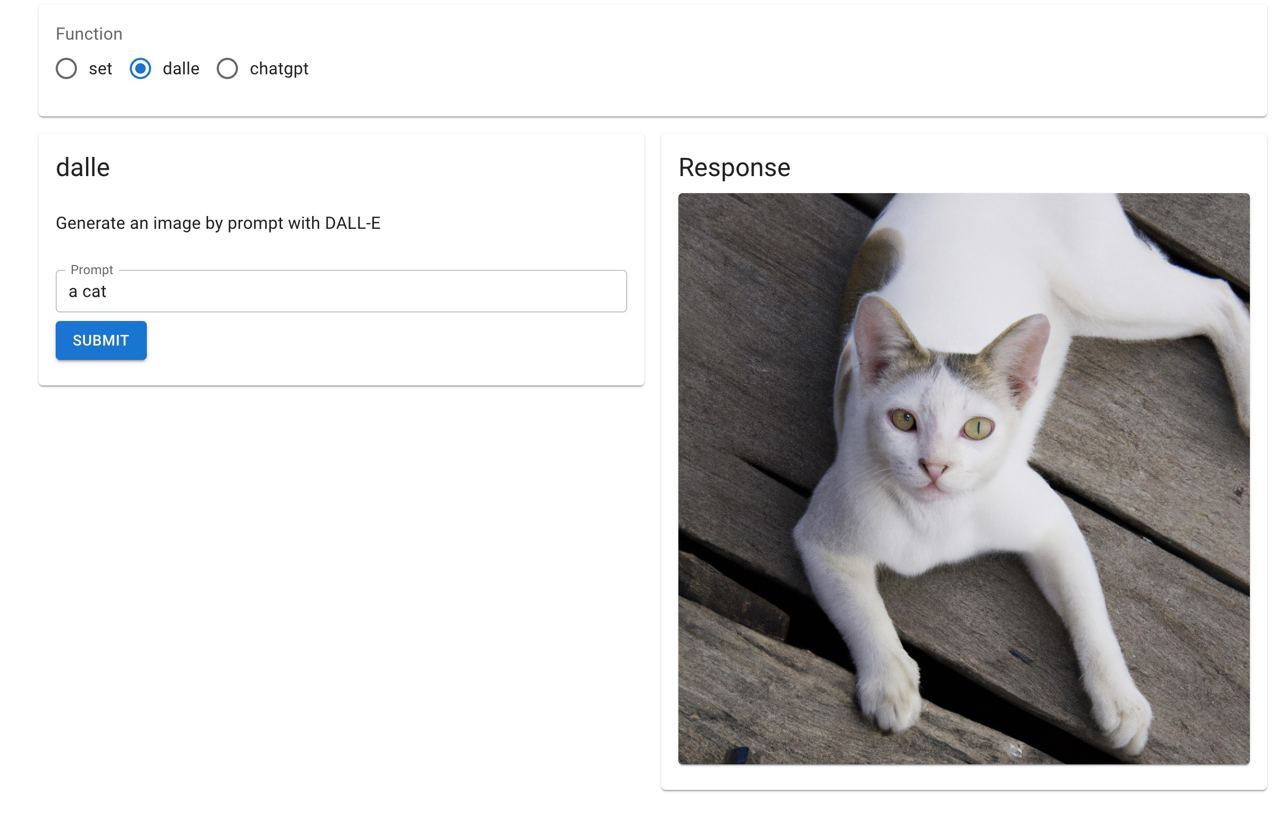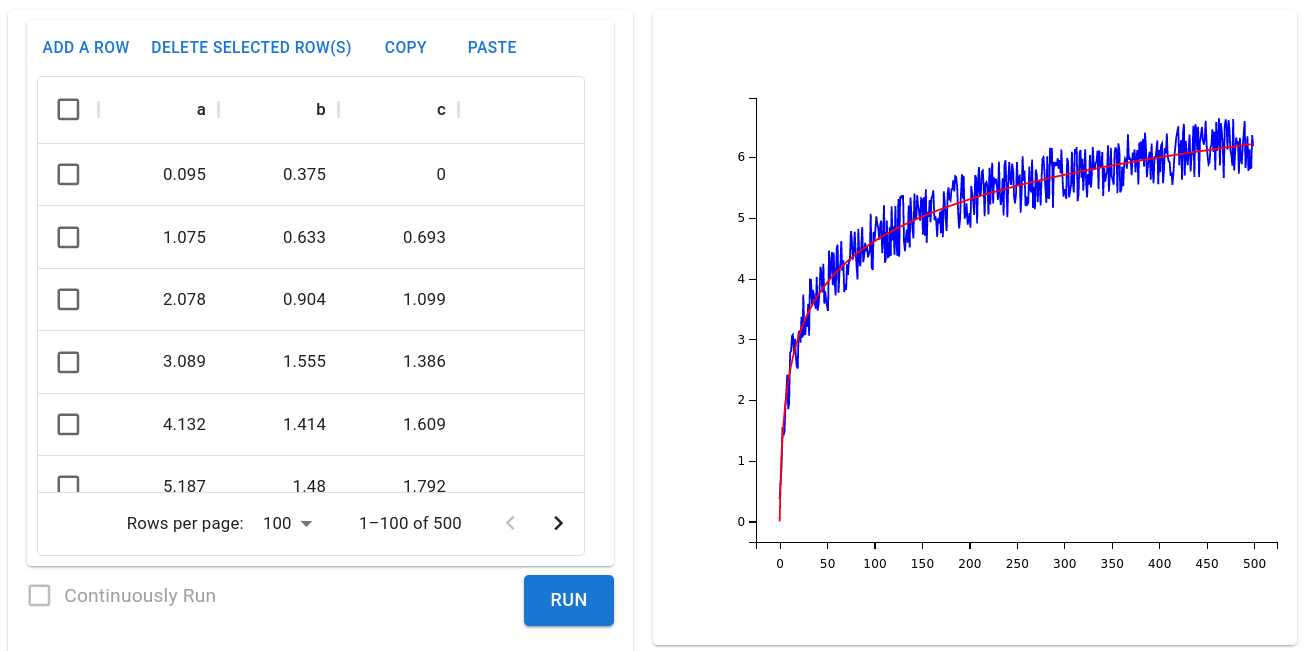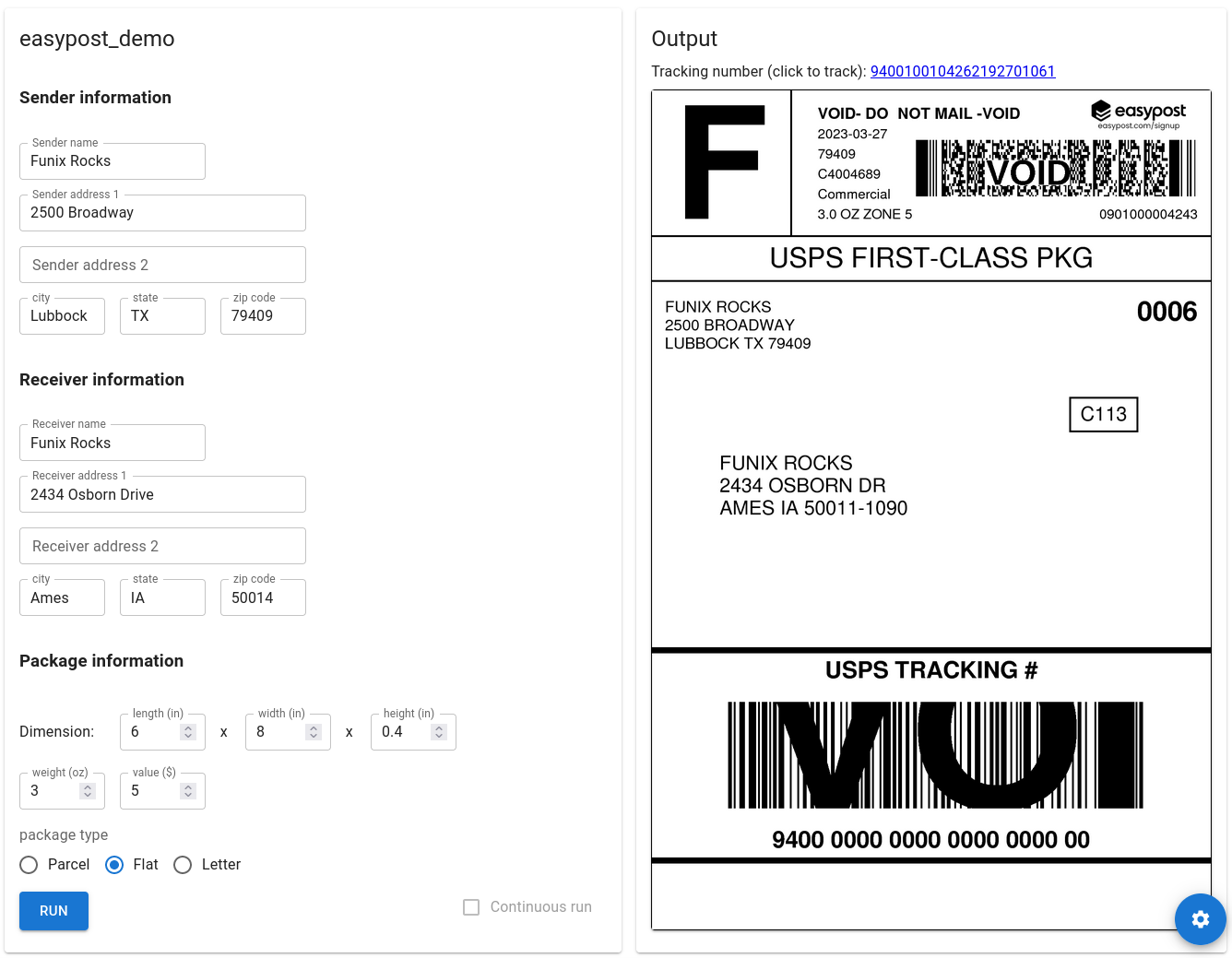Building web apps without manually creating widgets
Project description
Funix.IO
⭐️ The laziest way to build AI/data apps in Python. ⭐️
Intro video | QuickStart Guide | Reference Manual | Gallary
https://user-images.githubusercontent.com/438579/236646521-30ed67f4-4708-4cf1-858d-33b65bc53b6a.mp4
Features
Funix is designed for an algorithm/ML engineer to build apps without writing code related to the UI, not even selecting a widget and passing it to or calling it in a Python function.
- Minimalist: Automatic UI generation. No manual widget selection.
- Centralized styling: Type-to-widget mapping stored in themes for cross-app UI consistency.
- Declarative: All non-default controls, including UI customization, via Python dictionaries.
- Non-intrusive: You can still run or debug your Python code locally as usual.
WIP: Funix is still under development. If you have any questions, please feel free to open an issue.
Hello, world in Funix
Building a web app in Funix is super easy. Just have a type-hinted Python function:
def hello(your_name: str) -> str:
return f"Hello, {your_name}."
Save in a file (say hello.py) and pass to Funix:
funix -l hello.py
A web app will be launched at http://localhost:3000 and automatically opened in a browser window.
Note: The
-lflag stands for "lazy" meaning that only default settings are used. It cannot be used when your function is decorated by the funix decorator@funix()which allows you to customize your app. See example usages below of the decorator.
Love Funix? Give us a star
Installation
-
From PyPI (stable)
pip install funix
-
From GitHub (latest)
pip install "git+https://github.com/TexteaInc/funix.git"
-
Local development
git clone https://github.com/TexteaInc/funix cd funix pip install -e .
Add
--prefix=~/.localif pip insists to install to system paths. See #24 and #23
Gallery
More examples in QuickStart Guide or the examples folder.
ChatGPT, multi-turn
Code here. Just 77 lines including the HTML layout code and tip messages.
Shortest Dall-E web app in Python
from funix import funix # add line one
from funix.hint import Images # add line two
import openai # pip install openai
openai.api_key = os.environ.get("OPENAI_KEY")
@funix() # add line three
def dalle(prompt: str = "a cat") -> Image:
response = openai.Image.create(prompt=prompt, n=1, size="1024x1024")
return response["data"][0]["url"]
Compound UIs
from typing import List
import matplotlib.pyplot as plt
from matplotlib.figure import Figure
@funix(
widgets={
"a": "sheet",
"b": ["sheet", "slider[0,1,0.01]"]
}
)
# below is a simple matplotlib function
def table_plot(a: List[int], b: List[float]) -> Figure:
fig = plt.figure()
plt.plot(a, b)
return fig
Layout
Code here
Usage
Command line
funix [-h] [-H 127.0.0.1] [-p 3000] [-F] [-B]
Funix: Building web apps without manually creating widgets
positional arguments:
main_class The Python module containing functions
to be turned into web apps by Funix
options:
-h, --help show this help message and exit
-H 127.0.0.1, --host 127.0.0.1
Host of frontend and backend
-p 3000, --port 3000 Port of frontend and backend
-F, --no-frontend Disable frontend server
-B, --no-browser Disable auto open browser
The command funix above is equivalent to python -m funix if you have installed Funix.
For example, to launch examples in the examples folder, run the following command:
cd examples
funix examples # same as `python -m funix examples`
funix examples_better # same as `python -m funix examples_better`
Call funix in Python
Besides starting Funix servers from the command line, you can also start Funix from Python:
import funix
funix.run("localhost", 4010, "examples")
How to contribute
Funix is open-sourced under the MIT License. Community contribution is not only welcomed but desired. Feel free to fork and make a pull request when you are ready. You can also report bugs, suggest new features, etc. via the issue tracker.
Acknowledgement
Funix draws inspiration from FastAPI and Plac: building software interfaces by inferring from function signartures containing type hints. We port this idea from the backend (FastAPI) or the terminal (Python-Fire) to the frontend. We also wanna thank Streamlit, Gradio, PyWebIO, and Pynecone. They inspired us. We are just too lazy to manually define widgets imperatively. Funix’s backend is implemented in Flask and the frontend in Material UI. Lastly, Funix was made possible with the generous investment from Miracle Plus (formerly Y Combinator China) to Textea Inc.
Team
The Funix team at Textea consists of:
Project details
Release history Release notifications | RSS feed
Download files
Download the file for your platform. If you're not sure which to choose, learn more about installing packages.
Source Distribution
Built Distribution
File details
Details for the file funix-0.4.4.tar.gz.
File metadata
- Download URL: funix-0.4.4.tar.gz
- Upload date:
- Size: 2.4 MB
- Tags: Source
- Uploaded using Trusted Publishing? No
- Uploaded via: twine/4.0.2 CPython/3.11.4
File hashes
| Algorithm | Hash digest | |
|---|---|---|
| SHA256 |
ec171e1418e41e8cb515f305ffe69d3c3de3af117c9e9ebde073eec95347e023
|
|
| MD5 |
4a374044844741a5621bebcb545ef175
|
|
| BLAKE2b-256 |
51a4a5a8e3ca9b41b587afb27be97bc6f036299a924175e5dc40da717190633c
|
File details
Details for the file funix-0.4.4-py3-none-any.whl.
File metadata
- Download URL: funix-0.4.4-py3-none-any.whl
- Upload date:
- Size: 2.4 MB
- Tags: Python 3
- Uploaded using Trusted Publishing? No
- Uploaded via: twine/4.0.2 CPython/3.11.4
File hashes
| Algorithm | Hash digest | |
|---|---|---|
| SHA256 |
7e64175bc5776c1cdc17f3b2f8eea4ac33fdb9d0f0671bedc4cc1732f61aea3c
|
|
| MD5 |
50ed65fd4dc4fcf4f703ea9d69a1d98e
|
|
| BLAKE2b-256 |
7414c1685019fd2b7f4f6f1b100a42a4eff7e486c1c03eb26d28ae1aab7d328d
|





